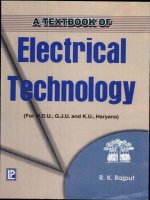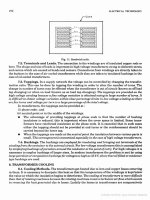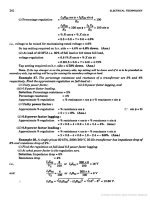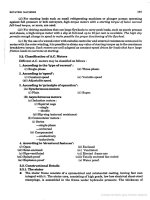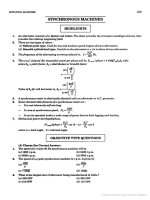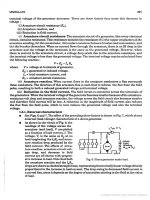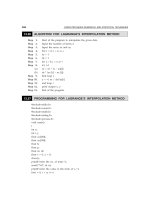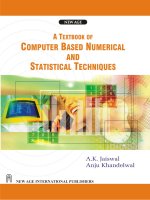Arun bahl, b s bahl a textbook of organic chemistry s CHAND COMPANY LTD (1976)(1)
Bạn đang xem bản rút gọn của tài liệu. Xem và tải ngay bản đầy đủ của tài liệu tại đây (27.67 MB, 914 trang )
TEXT-BOOK OF
ORGANIC CHEMISTRY
v
(FOR B.Se. STUDE.NTS)
by
8.S.
~AHL. M.Se .•
Principal. O.A. V. College. jul/uodur City
Fellow and SyndIc; Member, Boord o(Studies in Chemistry.
C.N. University. Amril$or
AND
ARUN BAHL.
M.S. (Boston). Ph.D. (Edi~burgh);
A.Po ..C. (London).
Deportment of Chemicol £n, ineerin, ond 'TeChn%lY.
Ponjab Universily. (;hondigorh.
EL1lVEN'l'H RIflVlSJl() ~Dl'l'10}1
1976
S. CHAND & COMPANY LTD
RAM NAGAR, NEW DELHI-lIOO5S
www.pdfgrip.com
s.
CHAND &.COMPANY LTD.
RAM NAGAR, NEW DELHI-II0055
Show Room
4116-B, Asal. Ali Road, New Delhi·nOOOl
Branches:
Mai Hiran Gate, Jullundur-14400l
Aminabad Pa.rk, Lueknow-226001
Blackie Houge,
103/5, Walch and Hirachand Ma.rg,
Bombay-400001
35, Mount RO,a.d, Madras-600002
Sultan Ba:l.a.r, Hydci'abad·500001
285/J, B!pin Behari Ganguli Street,
Calcutta·700012
Khazanchi Road, Patna-800004
Mundhada. Bhawan,
Gandhi Sagar East N agpur-440002
KPCC Building,
Race Course Road, Banglorc-560009
F;"e Editton 1949, SubleguefU Bdittons 1953, 1956, 1958,1959, 1961, 1963,
1964, 1965, i966, 1961, 1968, and Re]Wlnt81969, 1970, 1971, 1972, 1'73
and 1914 (Twice) Reprinted 1976
Reprinted July 19i8
56/1
Rs.10<00
Published by S. Chand & Company Ltd, Ram Naaar, New Delhi. I 10055 and Printed
at Rajendra Ravindra Printers (Pvt) Ltd, Ram Naaar, New Deihl· I 10055
www.pdfgrip.com
'PREFACE TO ELEVENTH EDITION
Some modern concepts of Organio Chemistry such llS the
Orbital ooncept of bonding and the mechanistic prinoiples of Orgl1.nio
reaotions were introduced in the previous edition of the book Th~
authors are happy that these new innovations were appreciated &nd
the 10th edition of the text· book of Organio Chemistry had to be
reprinted in 1969 and ag!loin in 1970. That was the first· phase of
modernjsing the subjeot matter whiQh has been followed llP in the
eleventh edition of the book. The new edition has .been consider.
ably enla.rged a.nu improved in all respects. The chief features of
the new edition are:
(1) A separate chapter covering the prinoiples of mechanism of
organio reactions has been given and these principles have been
applied to interpret the mechaDlsm of almost aU important reao·
tions in the remaining portions of the text.
(2) A new ohapter t>n 'Classification an~ Nomenolature' giving
details of the la.test lUPAC ~ystem of naming all olasscs of organic
oompounds has been inoluded. The naming of higher organic com·
pounds on the basis of 'seniority of functional groups' is the latest
innovation that has al90 been desoribed.
(3) Some modern topics such as sublimation under vaouum,
cbromatography, oxygen. Bask method for estimation of halogen!,
direct estimation of oxygen have been given.
(4) Spectroiloopy of organic compounds espeoially the ul~ra..
violet u.nd Infrared spectra, their explanation and application to
some important substances is a new feature of this edition.
(5) The descdption of Optical IsoIDerism has been siven
modern touches and It and S conventions ha.ve been dls'Cluss.ed in
detail.
(6) Under the chapter on tt1kanes thfl new topio 'Conformations
of ethan~ and propane' hl\s been included.
(7) The ohapter on 'Carbohydrates' has been re·written and
erilarged so as to give the latest conventions of writing st.ruotural
fOl'IJlulae of aldoses.
(8) Numerous new illustrat;ions of industrial prooesses, mecha.
Dism of reactions, molecular monels, the. geometry of certain organio
molecules form a novel feature of this edition.
(9) The latest numerical problems Ilnd questions askE'ri in the
various universities of India have been inoluded at tho end of each
cha.pter.
The lLuthors hope that the eleventh revised edition of the book
which bas been rewritten and modernised in many respects wi1l be
well received bv Oll\, colleagues and the student tlommunity. Any
suggestionM for further improvement of the book will be noknow.
ledged with thanks.
JuU'IJ,lI.dur
B.S.BARL
AnuN BA.HL
July. 1970
www.pdfgrip.com
CONTENTS
PAGE
CHAl'TEB
1. Introduction
2. Puri'fioation of Organio Compounds
3. Composition of Organio dompounds
4. Empirical and Moleoular Formula.e. Determins.tion of
Molecular Weights
5. Structure of Orga.nic molecules. Classical Concept
6. Structure of Organio Molecules. Modern Concepts
.7~ Isomerism
8. Organio Reactions and Their Mechanisms
9. Cla.ssification and Systematic Nomenclature
ALIPHATIO
1
9
26
46
68
83
111
139
176
CoMl'OlJ'NDS
10. Alkanes
201
ll~
250
278
298
321
330
Alkenes
12. Alkynes
13. Halogen Derivatives
14:. Orga.no-Meta.Ui~ Compounds
15. Aliphatic Alcohols
16. Alipba.tic Alco~ols' (Continued)
17. Thioalcohols Imd Thioethers
18. Ethers
19. Aldehydes and Ketones
00. Car}>oxylic Aoids
21- Dicarboxylio Acids
22. Substituted Acids
23. Acid Deriva.tives
24. Esters
25. Acetoacetic Ester and Malonic Ester
26. Fats. Oils and Soaps,
27. Ami.nes
28. Cyan'ogen Compounds
·29. Derivatives of Carbonio Acid
30. Aliphatic Diazo Compounds
Cycloalka!les
AROMATIO CoMPOUNDS
32. The Ureides
33. Carbohydrates
34. Proteins
.!,.
......
388
402
444
~
;
..
...
470
481
501
514528
540
549
o7l
580
589
593
J1.
www.pdfgrip.com
365
'3~0
..•
598
G06
642
( viii )
PAGE
650
659
CHAPTER
35. Introductory
36. Benzene and its Homologues
37. Isomerism and Orientation of Benzene Derivativ~s
38. Aromatic Halogen Compol,lnd&
39. Aromatio Sulphonic Aoids
40. Aromatic Nitro COmpol,nds
41. Aromatic Amines
42. Diazonium Salts
43. Aromatio Hydro~y Derivatives
44. Aromatic Aldehydes and Ketones
45. Aromatic Carboxylic Acids
46. Colour and Constitution. Dyes
47. No. phtha.lene and its Derivati'\'t's
48. Anthracene and its Derivatives
49. Heterocyclic Compounds·
50. Heterocyclic ('.ompounds (Continued)
51. Alkaloids
62. Terpenes nnd Rel~ted Compounds
Index
www.pdfgrip.com
.,..
..
...
...
687
704
717
726
738
759
767
789
805
821
8S2
843
854
867
S77
800
9()2
www.pdfgrip.com
www.pdfgrip.com
TEXT-BOOl{ OF ORGANIC CHEMISTRY
inorganic compounds.
(NH4 )2S0,
+
Amm. sulphate
2KCNO __ 2NH"CNO + KIISO"
Amm. cya.na.te
NH.CNO
--to
NH 2CONH2
Urea.
This simple reaction did much to dispel the absurd idea of vital
force in the formation of organic compounds. A few years later
Kolbe was able to synthesise acetic acid starting from the elements
carbon, hydrogen and oxygen, thuEj showing clearly that no sperial
life process was needed for the preparation of organic compounds.
Thereafter numerous organic compounds were synthesised in the
laboratory and by 1850 The Theory of Vital Force had been gradually
overthrown.
Modern Definition of Organic Cheulistry. With the fall
of the Vital force theory, the term 'organic' lost its original significance. It was, however, established that all the so· called organic
compounds contained carbon as an essential constituent. Therefore,
the name 'organic' has been retained to describe all carbon compounds irrespective of their origin or the- method q£ preparation.
Thus in modern practice the term Organic Chemistry is defined
as the study of the compounds of carbon, the study of the rest of the
elements and their compounds falling under the scope of Inorganic
Chemistry. However, a few common compounds of carbon like
carbon monoxide, carbon dioxide-and carbonates are still classed as
inorganic substances for obvious reasons.
Thus the modern definition of Organic Chemistry could' be
given as the study of compounds of caroon other than the oxides,
carbonates and bicarbonates, a:r:d hydrogen cyanide and its salts.
Since all the organic compounds could be considered as deri ved
from hydrocarbon~ (containing C and H only), a more precise definition of Organic Chemistry could be given as
"A study of hydrocarbons and their derivatives."
REASONS FOR SEPARATE STUDY'
The organic compounds obey the same fundamental laws of
Chemistry that hold for Inorganic compounds. However, they are
studied as a separate branch of Chemistry as a matter of convenience
mainly for two reasons :
(1) The total number of organic compounds known is about
20,00,000, which exceeds several times the total number of inorganill
compounds which is hardly 50,000. If. the E!tudy of twenty lakbs of
carbon compounds be ineluded with that of carbon in Inorganic
Chemistry, it would throw the subject out of balance.
(2) There are marked differences between the composition,
structure and behaviour of the organic and inorganic compounds
which make their sepa.rate study more fruitful.
www.pdfgrip.com
3
nrrRODUCTION
The chicf (liffcrellces between organic and inorganic compounds
are statE'd below :ORGANIC
INORGANIC
______ ------------------(I) Organic compounds are
built mostly from 10 elements viz.,
0, H, 0, N, S, P, Cl, Br, F and I.
11) Inorganic substances are
formed from any of 101 elements
known.
/. (2) Carhon has the wonderful
c8.pacity to unite with itself and also
'\Vith other elements with the help of
covalent bondB. Carbon atoms joined
each to each in straight chains or rings
give rise to the formation of a large
number of simple as well a8 complex
compounds with hugo molecules.
i
(2) The atoms in the molecules
of inorganic substances are joined bv
electrovalent bonds, forming relatively
simple and smaller number of compounds.
(3) Organic compounds with
similar 'groups of aoolils' display similar chemical behaviour. Thus they
form many such classes of compounds
e.g., alcohols, ethers, ketones, acids,
am/nes, etc.
(3) Most of the inorganic compounds which have been studied are
either acids, baBes, or 'BaltB.
(4) They frequently possess
pronounced colour and odour whic}_!
are characteristic of certain classes of
compounds.
(4) They are. in general, colourless and odourless. Certain metallic salts possess distinct colours.
(5) They are. in general, insoluhle in water but soluble in organic
solvents such as
ether, alcohol,
benzene etc.
(5) They are generally soluble
in ·water but insoluble in organic
solvents.
(6) They are volatile compounds having relatively lower melting points and boiling points.
(6) They are generally nonvolatile and pOBSess high melting points
and boiling points.
(7) Burn readily. Solutions
(7) Hard to burn. Conduct
and melts do not conduct electric electric curr.:mt in solutions and
current.
melt.
(8)
Their reactions being
'molecular' in nature are slow .and
usually complex.
(8) Their reaction!! for the
most part being ionic in na.ture are
rapid a~d simple.
(9) Covalent bonds being rigid
and directional, give rise to 'Cha.in'
isomerism' and different types of
'Space isomerism' in organic compounds'.
(9) Electrovarent bonds being
non-rigid and non-directional, cannot
give rise to isomerism in inorganic
substances.
\
(10) Law of multiple prop or.
. (10~ Law of m~ltiple proporis not applica- tions 1S umversally apphcable to inor_
ganic compounds.
~le to many organic compounds. In
such compounds the weights of an
element combining with ~fixed weight
f the other, bear only an integra.l
atio and not a. simple one.
....j-mB in its rigid form,
www.pdfgrip.com
4
TEXT.BOOK OF ORGANIC CHEl\lIS'l'R.
SCOPE OF ORGANIC CHEMISTRY
The scope of orga.nio ohemistry is vast indeed. There is no art,
soience or industry in which this branoh of chemistry is not applied.
It will be of interest to outline here very briefly some of the applioa.
tions of organio chemistry in everyday life and industry.
(1) Applications in Everyday life. No other branch of
science has so many contaots with human life as organic chemistry
has. In our day· to-day life we find ourselves in a strange panorama
of things that are in one way or the other conneoted with this branch
of chemistry. From the basic requirements of life like food, fuel,
clothing and health aids, to the obviollsly luxurious things like
perfumes and cosmetics -and in-between these two extremes come
Fig. H.
the following with varying degrees of importance: leather and wood·
en products; pencil, paper and writing inks; fuels like coal, oil 1l.11d
wood; dyes of all kinds whether na.tural or synthetic; rubber (4~~~\
plastics; oils, fats, paints and varnishes; photographic films an~
de\yelopers ; medicines, anaesthetics and antiseptics-all things seem
to have organic origin and touch. It is no wonder, therefore,
organic chemistry is a part and parcel of our daily life. In fact;
are ourselves nothing but complex structures b\1ilt of thousanl
I
www.pdfgrip.com
t
ODUCTJON
5
Ilnic compounds which are derived from the phmt and anima)
.
~~;;
s.
Applications in Industry. A knowledge of organic
is necessary in many important chemical industries, e.g.,
paratlOn of foods, pharmacy, manufacture of soap and other
'. 'metics, tcxtile industry, manufacture of dyes and explosives,
.' per il!dustr~, fertilizers, .101.1 the~ ind.ustry, :-mgar jndu~try, fermen'''tiOD mduiltrIes. woorl-(hsttllatlOn Industry, synthetIC rubber and
ft,i.nsparent wrappings for foods and other commodities, petroleum
iiiclustry, etc.
~- (3) Study of Life processes. The most important appIiatPon of organic chemistry is tht:! study of the nature of the material
. - of the proceH:;~R of living organisn~f'I The investigation of the
"ues, the seeretlollK and other constituents or prodnctR of plants
.Id animals is hnsed upon organic chemistry. The understan ding of
. . process of digestion and alltiimilation of food involves the funda.tal principles of organic chemish:y. The vitamins and the hoI"
.•mes are organic compollnd~ that Rre produced in our body' and
,91.y an important role in its development. 'fhe injection of a horIIIOne can turn a male into femalc and vice versa. All such miracles
or.nature concerned with the life process can be interpreted only by
aid of organic chemistry.
(2)
"eznistr~
'"I'''
.8
DYES
PLAS TICS 4<
~f'SINS
PHARMAClUTICALS
SOAPS
HUSBER
,
PAINTS
Fig. 2·2. Proportions of synthetio a.nd natura.l products capturiIig
in
Thero are other fields of organic chemistry at present less
deyeloped. Further researches may bring thest' in the front rank.
This naturally means a more thorough study of what we already
know. The subject itself is worthy of study from the purely scientific and cultural Rtandpoint. The intellectual beauties of the closely
inter-~oyen relations of organic chemistry will be revealed to the
,,~nt only when he studies the subject logically, keeping before
'.~!!l the molecular structure of the compounds involved.
I
\'JCES OF ORGANIC COMPOUNDS
'"
Organic compounds are obtained from natural sources and are
prepared by syntheliis ill the laboratory. The natural sources
www.pdfgrip.com
TEXT·BOOK OF ORGANIO CHEMISTRY
of these substances may be traced to either the plant
kingdom. Thus:
Sources of
Organic Compounds
r
I
Natural
I
(
or animal
•
I
Laboratory
Synthesis
I
Ammal
kingdom
Plant
kingdom
SOURCE
COMPOUNDS OBTAINED
(1) Plants (direct)
Sugars, starches, cellulose, citric acid, oxalio acid,
tartaric acid, indigo, oils, vitamins, etc.
(2) Animals
Fats, proteins, urea, uric acid, vitamins, hormones,
etc.
(3) Wood distillation
Acetic acid, methanol and acetone.
(4) Coal·tar distillation
Benzene, tolullne, naphthalene, carbolic
cresols, pyridine, dyes, perfumes, drugs, etc.
(5) Natural Gas and Pet.
Alkanes ond their derivatives such as methyl
chloride, chloroform, methyl alcohol, ethyl alcohol,
allyl chloride, etc.
roleum distillation
t6) Fermentation processes
acid,
Ethyl alcohol, amyl alcohol, acetic acid, etc.
About 40 years back, the main sources of organic compounds
were the processes of fermentation and wood distillation, while
fewer compounds were derived from coal and petroleum. With the
recent development of petrochemical industry and low. temperature
coking techniques of coal, the number of carbon compounds now
derived from petroleum and coal is far greater than from any other
source. While the fermentation processes are still in use for the
preparation of a large number of organic compounds, wood distilla.
tion is almost obsolete and replaced by synthetic methods.
How long the World's Coal and Petroleum Reserves would
last ~
COlli and petroleum are undoubtedly the biggest natural sources
of organic compounds. For the past 100 years coal dominated the
scene but during the last 20 to 30 years, petroleum has assumed
comparable importance. To meet the great demand of organic
compounds, the world's production of coal increased enormou!t~y41
during the last decade or so. In 1966 the total productiop C '':.u('
was 2,800,000,000 long tons. Although coal is far more
SOU
and widely distributed in nature, petroleum resourc~~
also
www.pdfgrip.com
i
nrrRODUCTION
equally vast. The total crude oil production of the wOl.'lcL in the
year 1966 recorded 1,601,000,000 long tons
A chemist is naturally interested to know the extent of world's
cOal and petroleum reserves as also the pr. bable time of their
oonsumption. Ultimately it is he who has to face the problefu of
replenishing their consumption by other synthetic means. The
'World's total coal reserves are estimated to be 5,562,656 million
long tons, while oii reserves as estimated on Dec. 31, 1966 amount
to 2,886,915 million long tons.
.
There are many speculations regarding the coal and oil supply
of the world. According to some specialists, the reserves are enough
fiO last for a .few generations even at the present rate of production.
Prof. N.N. Chatterji puts India's total reserves of coal at 20,000
JJ)illion tons which are sufficient to laoat for another four centuries.
India's oil reserves are estimated to be 6580 tons only.
FOOD
Fig. 1·3. Decay and Formation Cycle of Coal and P'etroleuJll.
At the present rapid rate of depleting the natural resources of
coal and petroleum, some economists are raising alarm for their
'conservation by other sources of energy. In this context, it may
be pointed out that due to the external reaction between carbon
dioxide and water in presence of sunlight (Fhotosynthesis), the
organic compounds are being produced continuously in plants.
Photosynthesis
C02+H20+Sunli!lh~ - - . _ Organic
compds +02
.....').'he organic compounds whether in the form of coal or petroleum
on' combustion give back CO 2 •
www.pdfgrip.com
www.pdfgrip.com
www.pdfgrip.com
TEXT.BOOK OF O~GANIC CHEMISTRY
10
CRYSTALLJS",-rION
. '
'Th
.
ost general method for the purificatlOn of sohd orgamc
e Jll
•S crystallisation 1n principle it is the same as employed
1
rr
su bstanoes
' . salts. Th e onI y d'Iuerence
.
t'h a t
IS
for inorganIc
here, in addition to water, several other sol.
ven ts arc used. The more common solvents are
a~etone, alcohol,
ether, chloroform, benzene,
etc.
Procedure. A solvent in which-the' given
substance is more soluble at higher temperature
than the room temperature is selected. The
solvent is heated with excess of the solid sub·
stance. The saturated solution thus prepared is
filtered while still hot. As the filtrate cools, the
pure solid crystals separate which may. be
removed by filtration.
rreparation of the 80lution. A suitable
quantity of the powdered substance is' taken,
say, in a conical flask and treated with a small
quantity of the solvent. The quantity of the
solvent should be just enough to dissolve the
whole of the solid on boiling. In case of vola.
tile solvents, it is advisable to fit the vessel with
ll. long glass tube which serves as a condenser
and also prevents the inflammable solvent vap.
ours to re~ch the flame of the burner. The
heating may be done on a water-bn.th or wire
Fig. H. PrepGration gauze according as the solvent is 'low.boiling' or
of 801ution.
'high-boiling'.
Filtration oj the .solutio". The hot saturated sC?lution obtained
above is then filtered through a fluted filter-paper placed in an ordina.ry glass funnel. If the quantity of the solution is large, it takes
HOT SAT
SOU/T/ON
Fig. 2'2. Filtration through
fluted filter paper.
Fig. 2·3. Hot-water funnel.
www.pdfgrip.com
PURIFIOATION OF ORGANld COMFOUNDS-
longer time to filter and the crystals may form in the funnel during
filtration. To prevent this, a "Hot·water funnel" may be used
with advantage.
OrystalliSation. The filtrate is ailowed to cool undisturbed in a
beaker or a "crystallising dish". After some time the solid substance
separates in beautiful geo·
c;r::>
metrical forms called crys.
..a_
tala: Sometimes the orystals
do not a.ppear due to super.
cooling of the solution. In
such a. case the crystallisa.
tion is induced either by
scratching the sides of the
vessel with a glass rod or
by sowing a few crystals of
the same substance in solution.
Separation and Drying
of OrY8tal8. The crystals
are separated from the
mother liquor by filtration.
This may be done more
rapidly with the help of a
Buchner funnel and
a
suction pump' as shown in
Fig. 2,4. When tfie whole
Fig. 2.4. Filtration under suction.
of the mother liquor has
been drained into the filtration. flask, the crystals are washed two 01
three times with small qua.ntities of the pure solvent. The filtel
paper carrying the crystals is then placed over a porous plate ani
driad in a steam or air.oven ..
Sometimes, the crystals obtained are coloured owing to th
traces of impurities pres,ent. In such cases, the crystals are radii
solve!1 in a small quantity of the sQlvent, boiled with a .little rmiml
charcoal, filtered and crystallised once again as described abov
The process is repeated till the substance is obtained in absolute
pure form as indicated by its sharp melting point.
SUBLIMATION
Certain substances when heated, pass directly from the so
to the vapour state without melting. The vapours when cooled g
back the solid SUbstances.
This process known as sublimation is very helpful in' se
rating volatile from non-volatile solid. It is, however, of limi
application as only a few substances like naphthalflne, camphor
benzoic acid .can be .purified by this process ..
The impure substance is placed in a china dish which is ge
heated on a sand-bath. The dish is covered with a perfora~d fl
paper over which is placed an inverted funnel. The vapours r
from the solid pass through the holes in thA filter-PiiPer an(
www.pdfgrip.com
12
TEXT·HOOK OF ORGANIC OHEMISTRY
deposited .as solid on the walls of the funnel. The filter paper has
two functl~l1S : (i) it does not permit the sublimed substance to
drop bac~ lDto the dish and (U) it keeps the funnel cool by cutting
off the dIrect heat from the dish (Fig. 2'5).
COTTON Pl.U6
WATtR 4-
_r-WATfR
J1 ff
-.TOPUNP
CRUDE
SU6STANCE
Fig. 25.
Sul'limatioD.
SUBLIMATE
Fig. 2'6. Sublimation under
reduced pressure.
Organic substances such as b-enzoio acid. naphthalene etc. which
• igh vapour pressure at tempe.rature$ below their melting
can be sublimed relatively quickly. These can be conveni.
urified by the laboratory operations described above. Auch
WATER
l
Fig. 2·7.
Sublima.t.ion tinder VACuum.
www.pdfgrip.com
"Pt]RIFIOATlON OF ORGANIO COMPOUNDS
13
substances which have very small vapour .pressure or tond to
decompose upon heating, are purified by s\lhlimation under reduced
pressure
A simple glass apparatus now used for sublimation under red·
uced pressure is shown in Fig. 2·7. 'l'he cbieffeatures of this appara·
tus afe a large heating and a large cooling surface with a I-;mall
distance in between. This is necessary because the amount of the
substance in the vapour phase is much too small in case of a
substance with low vapour pressures.
.
DISTILLATION
The operatlOn of distillation is employed for the pnrification of
liquids from non· volatile impurities. The impure liquid is boiled in a
flask and the vapours so formed are collected and condensed to give
back the pure liquid in another vessel. The non·volatile impurities
are left behind in the flask.
The apparatus used for distillation is shown in .Fig. 2·7. It con·
sists of a distillation· flask fitt"d with a thermometer in its neck llnd
a condenser at the side· tube. The liquid to be purified is placcd in
th& tlistillation·flask and the thermometer so adjusted that its bulb
$tands just below the Qpening of the side-tube. This ensures the
correct recording of the temperature of the vapour passing over to
the condenser. A suitahle vessel is attached to the lower end of the
condenser to receive the col\densed liquid. On heating the distil.
lation flask the thermometer iir.st records a rise in temperature
whic.h 500n (lecomes constant. At this point, which is the boiling
temperature of the pure liquid, most of the liquid passes over.
Towards the end of the operation the temperature ri~9 once again
on account of the superheating of the vapour. The distillation is
~topped at this stage and the receiver disconnected.
In case of liquids hn.\ting, boiling points higher than 110° C, the
water.condenser is replaced -by n·ir condenser.. To prevent bu mping,
it is customary to put a few pieces of unglazed porcelain in the
. distillation flask.
While distilling a very volatile and infianullnble liquid snch as
ather, t)\e distillation flask is heated on a water.bath and not on"a
wire gauze. In case of very high. boiling liquids, the flask is heated
directly with a naked flame.
FRACTIONAL nISTILLATION
A mixture of two or more volatile liquids can be separated hy
fractlOnal distlilatlOll When their boiling points differ by more tha;l
40 0 , the operation can be <;ll.trried with the help Q1 ol'(imary distilla.
tion appara.tus described in Fig. 2'8. The inore voll.ttile liquid pasiSes
over first and is c()llecte~t in a receiver. When the temperature
hegins to ri8e for the second time, th i.> first receivel' is disconnected.
A Hew receivE-r i:; attachell ItS soon as the temperltture becomes
COllSt!1ilt once again. ThuR the distillate is celle-ctecl in fractions ancl
·thn process is termed Fractional DWillation.
When the liquids present in the mixture have their boiling
-~
www.pdfgrip.com
TEXT-BOOK OF ORGANIO OHEMISTRY
points close to each other, the separation is best effected by fitting
the distillation Bask with a fractionating column which in turn is
Fig. 2'8. Distillation.
connected to the cond-enser (Fig. 2'9).
ilit
On heating, the 'f"POUl~ of
rRACrIONA7:.1NG
COLUMN
'c~
(I~
~
"'II:
~
lIQUI/)
MIXTURE
Fig. 2·9. Fracti .al distillation.
www.pdfgrip.com
pl1R1li'lOATION OF ORGANIC OOMPOUNDS
10
the more volatile liquid A, along with.a little of the vapQut's of less
-volatile liquid B, rise up and come in contact with the large cooling
surface of the fractionating column.. The vapours of B condense
first and that of A pass on. The condensed liquid flowing down the
column meets the fresh hot ascending vapour. It snatches more of
B from the vapour mixture and gives up any dissolved vapour of A.
This process is repeated at every bulb of the fractionating column,
so that the vapour escaping. at its top consists almost exclusively of
A and the condensed liquid flowing back into the distillation flask is
Fig. 2·10.
Different types of fraotionating oolumns.
rich in B. If necessary, the process_c.'in be repeated with the distillate
and the liquid left in the distillation flask.
'
The ilse· of a fractionating column has found a remarkable
application. in modem industry, especially in the distillation of
petroleum, coal. tar and crude alcohol.
DISTILLATION UNDER REDUCED PRESSURE
The 'straight' distillation is suitable only for liquids which boil
without decomposition at atmospheric pressure. In case of organic
liquids which decompose before their boiling point is rea.ched, the
distiUa.tion is carri~d under reduced pressure when the liquid boils a~
a lower temperature·.
The apparatus us~d for distillation under reduced pressure is
shown in Fig. 2) L
(i) maisen Flask, having ,two necks. It is fitted with a IOBg
drawn jet, dip;ping -in the liquid to be distilled. During the distIlla·
tion, a stream ·of bubbles rises through the capillary of this jet and
prevents bumping, which is so pronounced here than in ordinary
distillation
. *A liquid boils when its vapour pressure is equal to the atmospherio
pressure. When the pressure is reduced by suction, the liquid boils at a lower
temperature.
www.pdfgrip.com
16
TEXT-BOOK OF ORGANIC CHEMISTRY
(ii) Oondenser, connected with the Claisen flask on the one
hand and a filtration flask, serving as a reoeiver, on the other.
Fig 2·ll.
Distillation under reduced pressure.
(iii) Manometer. The reoeiver flask is connected to an exhaust
pump through (a) a mercury manometer which tells the pressure
under which the distillation is being carried, and (b) a trap, to eliminnte any condensed liquid.
The preFisure in the apparatus is reduced with the help of 11
water pump. Whenever a lower pressure is desired, the water pump
is replaced by a mercury pump.
_~n important p.pp11cation of this proc.ess is the recovery of
glycerol from spent-lye in soap industry. Glycerol is decomposed
at its boiling point (298°0) but can be distiU(ld unchanged at 12 mol.
pressure when it boils at 180°. Another application of 'vacuum
distillation' is the concent.ration of sugar juice under redm'ed
pressure.
STEAM DISTILLATION
Many substances that nre insoluble in water are voiatile
in steam can be purified by distillation in a .:lurrent of steam' (Stea'1n
DistillatiQn.). The non-volatile impurities are left behind in the
distillation flask
The impure mbtturc together with SOIllle water IS placed ill a
round.bottom flask which is then connected to II Rtcnm·generator
on one side and n water ('ondenser on the other (Fig. 2-12) The flask
is Il.djuRted in a slanting position so that no droplets o.r til(' mixture
splash into the ('ondl'llSel' on brisk boiling and bubbling uf steam
The mixturt' in th(' flnKk is heated and then a current of stenm passe
nto it, HeatH'.~ of the flask is controlled so as to avoid unneoessurj
eondl'nsa,tion of stf'tlm in it. Steam pirks up the volatile substance.
www.pdfgrip.com
J>t1BmOATION OF ORGANIC COMl'OU:NDS
17
froID the mixture and passes into the condenser. The distiIlat.$
collected in the receiver consists of a m~xture of water and, the
organic substanue. The distillation is stopped when the droplets Ot"
,the solid particles of the organic substance cease to appear in "he
COndenser
Fig. 2'12.
Steam distillation.
The distillate is then treated to recover the organio substa.nce
by .. suitable method. In case it is a solid, the substance may be
separated by simple filtration, and if-it is a liquid, it can be rem.o...~
ed by means of a separating funnel. The aqueous layer in both ca.ses
may be extracted with a solvent.
Steam distillation is employed in. industry for the recovery of
various essential oils frOID plants a-nd flowers. It is also used in the
manufacture of aniline and turpentine oil.
Principle of Steam. Distillation. A liquid boils when its vapour ,Pres..
In steam, distillation, a mixture of
water and an organic liqUid is heated. The mixture boils when the combined
vapour pressure of water (1'1) and that of the organic.liquid (1'2) is equal to the
atmospheric pressure (P) i.e.,
.ur. is equal to the atmospheric pressure.
P"'Pl+P2
Naturally, the boiling temperature of the mixtura would be lower than the
boiling temperature of the pure organic liquid when tl\e va.pour pressure of this
liquid alone would be equal to the atmospheric pressure. Thus, in steam distil.
lation the liquid is distilled at 0. lower temper~ture than. it.q boiling point when
i, Jnlght decompose. It sorves the same purpose as distillation under reduced
p~ure.
BXTRACTION WITH A SOLVENT
When an organio substanc:e is present as solution in wa.ter, it
be recovered frOID the solution by the following steps:
-,
(i) The aqueous ,~ol'Ution is shaken with an immiscible org.:lnie
IOlvent in wMr;h the solute is mare soluble.
~n
www.pdfgrip.com
18
TEXl'-BOOK OF ORGANIC CHEMISTRY
(ii) The solvent layer is separated by means of a separating
funnel.'
(iii) The organic substance is then recovered from it by distilling
off the solvent.
The process of removing a substance from its aqueous solution by
shaking with a suitable organic solvent is termed BXTRAcrION. '
Procedure. The aqueous solution is placed in a separating
funnel. A small qua.ntity of the organic solvent, say ether or
SOLVENT
LAYER
AQUEOUS
LAYER
Before extraction
After extraction
Fig. 2,13. Extraction with a solvent.
chlqroform, is then anded to it. The organic solvent being immiscible with water, will form a, separate layer. The mouth of the funnel is closed with a stopper- or the palm of the hand and th'}
contents shaken gently. The solute being more soluble in the
organic solvent is transferred to it. •The solvent layer is then
separated by opening the tap and running Ollt thE! lower layer.
The organio substance dissolved in it is finally reco'Vered by distilling
off the solvent.
Note. It is always better to extract two or three times with smaller
qunntities of the solvent than once with the whole bulk of the sol"'mt provided.
Soxhlet Extrac:iion. When an orga'nic substance is to be
recover:1 from a solid, it is extracted by ~eansof an organic solvent
in which the impurities are insoluble. In actual practice the extraction from solids is often tedious and requires thorough
contact and heating _with the solvent. This is done in a special
apparatu~: the So!xkfet Extractor (Fig. 2'13).
It consists of a
glass of cylinder C baYing a side tube T and ~vnhon S. The
www.pdfgrip.com
